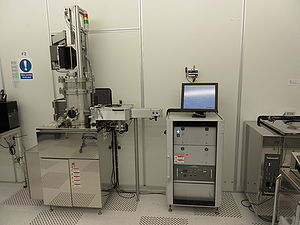Specific Process Knowledge/Thin film deposition/ALD2 (PEALD): Difference between revisions
| Line 44: | Line 44: | ||
'''The user manual, the user APV and contact information can be found in LabManager:''' | '''The user manual, the user APV and contact information can be found in LabManager:''' | ||
[http://labmanager.dtu.dk/function.php?module=Machine&view=view&mach=365 ALD 2 (PEALD) info page in LabManager] | |||
== Process information == | == Process information == | ||
Revision as of 15:08, 6 February 2017
ALD Picosun 200
THIS PAGE IS UNDER CONSTRUCTION
Feedback to this page: click here
ALD - Atomic layer deposition

The ALD 2 (PEALD) is used to deposit very thin and uniform layers of different materials, by use of thermal ALD or PEALD (Plasma Enhanced Atomic Layer Deposition).
The ALD deposition takes place in an ALD reactor chamber. In order to ensure that the temperature inside this reactor is the same everywhere, it has a dual chamber structure. The inner chamber is the reactor chamber, and the outer chamber is isolating the reactor chamber from room air. Both the inner and the outer chamber are under vacuum. The space between the two chambers is called an intermediate space (IMS), and the IMS is constantly purged with nitrogen.
When a sample is loaded into the reactor chamber, it will take some time before it reaches the desired temperature. Thus, it is important to include a temperature stabilization time in the deposition recipes.
The ALD depositions take place under vacuum, thus a vacuum pump is connected to the bottom of the ALD reactor chamber. The pump is located in the basement.
Different precursor lines are connected to the reactor chamber through separate precursor inlets. At the moment the available precursors are TMA, TiCl4, SAM24, TEMAHf, H2O and NH3, and soon O3 will also be available. These precursor lines are all purged with a constant flow of nitrogen.
The liquid precursor sources TMA, TiCl4 and H2O are stored in bottles located in a side cabinet on the left side of the machine. When the TMA and TiCl4 precursors are not in use, the manual valves have to be closed. The powder precursors SAM24 and TEMAHf are stored in bottles located in a big cabinet below the ALD chamber. These precursors are heated by heating jackets, and users should not open and close the manual valves. O3 is generated by use of an ozone generator that is located in the E-rack at the right side of the machine.
A remote plasma generator is connected to the upper part of the reactor chamber. Different precursor gases are connected to this plasma generator through the same gas inlet. At the moment the available plasma precursor gases are N2, O2 and NH3, and soon H2/N2 will also be available. The plasma gas inlet is constantly purged with argon. The plasma gasses can also be used as precursors for thermal ALD if the power to the plasma generator is not turned on.
The plasma generator is separated from the reactor chamber by a plasma cone (or chamber lid). The argon flow through the plasma gas inlet ensures that the plasma cone remains clean.
The plasma cone is not heated, and thus is will affect the temperature uniformity in the reactor chamber, and it will affect the gas flows and increase the necessary purge time. For that reason it is possible to mount a thermal lid between the plasma cone and the reactor chamber. However, it is quite time consuming to install the thermal lid as it requires that the machine is cooled to room temperature and vented. Furthermore, it is not possible to run plasma processes with the thermal lid installed.
The precursor pulse time is controlled by special ALD valves that allow very short precursor pulses to be introduced into the ALD reactor chamber and at the same time allow a constant nitrogen or argon flow. Thus, nitrogen and argon are always flowing through the ALD valves into the chamber, independent on whether a precursor pulse is introduced or not.
At the moment it is possible to deposit Al2O3, TiO2, HfO2, SiO2, AlN and TiN in the ALD. In order to deposit good quality nitride layers with low sheet resistance, the amount of oxygen has to be very low. Thus, the ALD reactor chamber has to be passivated before nitride depositions can be done, and oxides and nitrides cannot be deposited at same time.
Samples are loaded through a load lock. 6" and 8" wafers can be loaded directly in the load lock, while 4" wafers and smaller samples have to be placed on a 6" carrier plate or a 6" silicon dummy wafer with an etched recess. It is only possible to load one wafer or carrier plate at a time by use of the load lock.
The plasma cone is opened and closed, when samples are transferred between the load lock and the reactor chamber. Two buttons on the load lock are used to insert and retract the load lock arm from the reactor chamber. A window on the front side of the machine makes it possible to keep an eye on the reactor chamber and the sample during loading and unloading.
It is also possible to load a minibatch directly holder into ALD through a door on the left side of the reactor chamber. However, a training is needed in order to use the minibatch holder, and for nitride depositions the minibatch holder cannot be used as it requires that the machine is vented, and thus a possible nitride passivation will be ruined. Furthermore, the minibatch holder is not useful for plasma process, as the ALD material will only be deposited on the top sample(s).
The ALD is controlled by use of a computer with a touch screen that is situated next to the machine.
The user manual, the user APV and contact information can be found in LabManager:
ALD 2 (PEALD) info page in LabManager
Process information
- Standard recipes on the ALD2 tool
- Al2O3 deposition using ALD2
- TiO2 deposition using ALD2
- HfO2 deposition using ALD2
- SiO2 deposition using ALD2
- AlN deposition using ALD2
- TiN deposition using ALD2
| Equipment | ALD2 (PEALD) | |
|---|---|---|
| Purpose | ALD (atomic layer deposition) of |
|
| Performance | Deposition rates |
|
| Thickness |
| |
| Process parameter | Temperature |
|
| Precursors |
| |
| Plasma precursors |
| |
| Substrates | Batch size |
|
| Allowed materials |
| |
